Communication toolkit
More Trees Now runs (almost) entirely on the strength of volunteers. Therefore, an easy way to share communication tips to ensure the success of your event is indispensable! With the information, advice, tools, links, and downloads on this page, we aim to help you get started as effectively as possible.
Mobilise sapling rescuers for your event!
Mobilising people to join your event or local sapling rescue group is crucial. Each person who joins contributes to saving approximately 50 to 100 saplings at every event! With this page, our aim is to assist you in getting started. If you have any questions or require our support, please email us at [email protected].
Manuals
Just like riding a bike, once you learn how to organise a harvest day, you never forget! You have the choice to keep it as a small affair, perhaps with a few friends in your local neighbourhood park, or, you could turn it into a sapling rescue mission and invite as many people as you can muster. Follow these steps, and you’ll be all set. Let’s save some trees! Read the manual here.
A Tree Hub is a collection point for saved saplings. It can be as big or small as you desire. With the Tree Planner, you can easily organise a free tree giveaway. Follow these simple steps and review the entire manual here.
You have picked up your rescued saplings, what now? In this guide, we start at the beginning, and walk you through the entire process of planting a tree, from choosing your trees to collecting them, planting them, and taking care of them. Read more information here.
The Forestry Commission has created a fantastic tool that suggests the best tree species suitable for your planting location. Try it out here.
Download the buds chart here from Discover the Wild!
Discover the Wild has many more charts, such as leaves, wasps and other small animals. Check it out here.
Text
More Trees Now
Harvest Day
Tree GIve Away
Planting day
Whatsapp message
Call to action
Set an example
Images
Here, you will find photos, flyers, brochures, posters, and other imagery to ensure the success of your event.
general pictures - more trees now
Posters
Flyers
Presentations
Standard Press Releases
Send them to a local paper!
TITLE: FIRST MORE TREES NOW SAPLING RESCUE BEGINS AT [PLACE] WITH [NAME POTENTIAL PARTNERS OR VIP IF RELEVANT]
On [date], More Trees Now [locality/group name] are rolling up their sleeves to plant some trees. More Trees Now rescues saplings that grow in places where they cannot mature. These saplings are given away for free to anyone who wants to plant more trees. Surplus saplings are a source of home-grown, native and sustainable planting material. The method accelerates tree planting and thus combats climate change, restores biodiversity and turns climate concerns into climate action. Everyone is invited to join the sapling rescue mission..
- What: Harvest Day More Trees Now
- Where: [address]
- When: [date], from [start time] to [endtime]
- Sign up! [Insert the sign up link of your event here, you can generate one in the Tree Planner]
Enclose a nice picture, always credit the photographer.
Anyone can join
Thanks to local volunteers, the More Trees Now method has arrived in (locality). In partnership with (forester), we can rescue saplings that are due for removal due to [state reason]. The sapling rescue campaign is open to everyone. You can participate individually, with your friends and family, or as a team-building exercise with your colleagues, your local community group, or your school class. The method is straightforward and easy to learn for both young and old. No prior experience with trees is required; we’ll guide you through every step. All you need is enthusiasm!
Title
What makes your harvest day unique? If you’re organising this in association with another local group, a community woodland, or another NGO, tell us about it.
More Trees Now
Every tree produces hundreds of saplings each year. Most of these saplings will not survive to adulthood. They either disappear naturally due to competition, or they are removed as part of routine forest management. They grow in bogs, on hiking paths, or they are thinned out to make room for other types of plants and trees. These surplus saplings are a source of diverse, ecological, free, and native trees. By relocating these saplings locally, we can restore ecosystems and create more green spaces elsewhere. More Trees Now is an initiative based on Meer Bomen Nu, a Dutch initiative that has sparked a mass volunteering movement that has relocated over 1.4 million saplings in three winters in the most densely populated country in Europe. Our goal is to make tree planting accessible and free for all who are concerned about biodiversity loss and deforestation.
Note for the press (not for publication):
For more information please contact [name], [email], [phone number]
TITLE: [NUMBER] FREE TREES FOR (LOCALITY)
On [date], Tree Hub [locality/group name] are giving away [number] trees and bushes for free. These young trees and bushes are rescued saplings and shrubs from places where they were going to wither or be removed or shredded. More Trees Now saves saplings that grow in places where they cannot mature. Excess saplings are a source of home-grown, native and sustainable planting material. The method speeds up tree planting and thus combats climate change, restores biodiversity and turns climate concerns into climate action. Everyone who wants a tree can sign up below.
- What: Free Tree Give-Away
- Where: [address]
- When: [date], from [start time] to [endtime]
- Sign up! [Insert the sign up link of your event here, you can generate one in the Tree Planner]
Enclose a nice picture, always credit the photographer. This one is made by Brendan Smith, at Terryland Forest Park.
Anyone can join
Thanks to local volunteers, the More Trees Now method has arrived in your locality. The saplings to be given away range from 50 to 150 cm in length, while cuttings are approximately 200 cm long. All saplings have been rescued from places where they couldn’t survive. The Tree Hub currently stocks a variety of [number] species. We recommend visiting our website, which offers useful tools to help you select a tree suitable for your soil type, as well as a guide on how to safely transport and plant your tree.
Title
Say something about your Tree Hub. Is this your first giveaway? Have you also harvested the saplings? Include quotes from involved volunteers, speak to your motivation. If you’re organising this in association with another local group, a community woodland, or another NGO, tell us something about it.
More Trees Now
Every tree produces hundreds of saplings each year. Most of these saplings will not survive to adulthood. They either disappear naturally due to competition, or they are removed as part of routine forest management. They grow in bogs, on hiking paths, or they are thinned out to make room for other types of plants and trees. These surplus saplings are a source of diverse, ecological, free, and native trees. By relocating these saplings locally, we can restore ecosystems and create more green spaces elsewhere. More Trees Now is an initiative based on Meer Bomen Nu, a Dutch initiative that has sparked a mass volunteering movement that has relocated over 1.4 million saplings in three winters in the most densely populated country in Europe. Our goal is to make tree planting accessible and free for all who are concerned about biodiversity loss and deforestation.
Note for the press (not for publication):
For more information please contact [name], [email], [phone number]
Title: Tree planting event at [place]
On [date], More Trees Now [locality/group name] are rolling up their sleeves to plant some trees. At [planting location], young trees (saplings) will be planted to create [a forest/hedgerow/etc.]. The saplings used are rescued saplings. They have been rescued this winter from places where they couldn’t mature by volunteers from More Trees Now. Excess saplings are a source of home-grown, native and sustainable planting material. This new tree-scape combats climate change, restores biodiversity and turns climate concerns into climate action. Everyone is invited to join.
- What: Planting Day More Trees Now
- Where: [address]
- When: [date], from [start time] to [endtime]
- Sign up! [Insert the sign up link of your event here, you can generate one in the Tree Planner]
Enclose a nice picture, always credit the photographer. This one is made by Brendan Smith, at Terryland Forest Park.
Anyone can join
Thanks to local volunteers, the More Trees Now method has arrived in (locality). You can participate individually, with your friends and family, or as a team-building exercise with your colleagues, your local community group, or your school class. The method is straightforward and easy to learn for both young and old. No prior experience with trees is required; we’ll guide you through every step. All you need is enthusiasm!
Title
What makes your planting day special? Or are you organising this in the name of/ with another local group, a community woodland, or another NGO, tell us something about it! Include a motivation from the planting location and a vision from the future, paint them a picture with words and inspire people to follow your example.
More Trees Now
Every tree creates hundreds of saplings a year. Most of these saplings will not reach adulthood. They either disappear naturally due to competition, or they are removed in routine forest management. They grow in bogs, on a hiking path, or they are thinned to create space for other types of plants and trees. These surplus saplings are a source of diverse, ecological, free and native trees. By transplanting these saplings locally one can restore ecosystems and create more green areas elsewhere. More Trees Now is an initiative based on Meer Bomen Nu, a Dutch initiative which has inspired a mass volunteering movement that has transplanted over 1.4 million saplings in three winters in the most densely populated country in Europe. The aim is to make tree planting accessible and free for all who are concerned about biodiversity loss and deforestation.
Note for the press (not for publication):
For more information please contact [name], [email], [phone number]
THE MORE TREES NOW MASS TREE PLANTING CAMPAIGN TO START IN NATIONAL TREE WEEK
The Dutch NGO Urgenda (which won the world-first climate case) has become Netherlands’ second largest tree planting organisation within three years and now moves to the UK. With a combination of professional staff and tools plus thousands of volunteers we can save trees that would otherwise die and thus scale up tree planting activities. The project is called More Trees Now and starts this autumn.
The UK’s woodlands are in decline. Climate change, storms, droughts, pests, and single-species and exotic tree-planting schemes have decimated the native biodiversity. As a result, tree planting schemes are booming, yet we hear there are ‘not enough’ trees which halts large–scale efforts. A new campaign aims to remedy that by using another source: the forest itself. In the last week of November, a series of pilots starts that will work with the transplantation method. Native saplings in the forest that grow in areas where they cannot mature are transplanted to places where they will thrive to create new green areas. Originally developed in the Netherlands as a solution for tree shortages and slow-moving tree planting schemes, the method is unlimitedly scalable in all countries where saplings of native trees are abundant, and the autumn and winter is cold enough.
More Trees Now
Every tree creates hundreds of saplings a year. Most of these saplings will not reach adulthood. They either disappear naturally due to competition, or they are removed in routine forest management. They grow in bogs, on a hiking path, or they are thinned to create space for other types of plants and trees. These surplus saplings are a source of diverse, ecological, free and native trees. By transplanting these saplings locally one can restore ecosystems and create more green areas elsewhere. More Trees Now is an initiative based on Meer Bomen Nu, a Dutch initiative which has inspired a mass volunteering movement that has transplanted over 1.4 million saplings in three winters in the most densely populated country in Europe. The aim is to make tree planting accessible and free for all who are concerned about biodiversity loss and deforestation.
Pilots to start this November
This November the inventors of the transplantation method, who’ve applied it successfully throughout the Netherlands, will join local initiatives in Wakelyns, Corby, Hollyhead and Carrifran in rolling out the first transplantation pilots in the UK. Part of the program includes events where anyone can join in transplanting native trees from areas where they cannot mature to areas where they can. There will also be lectures on the IT system that the organisation has built. They have created an online tool which allows for a decentralized organisation where anyone can organize events and register and track saplings from their old to their new destination. The system will be freely available throughout the UK with these pilots.
Note for the press (not for publication)
xxxxxx
standard letters
Write to your local forester, tree NGO, municipality and much more with these standard letters.
Place, date
Concerning: More Trees Now in our [county/municipality/etc.]
Dear [….]
We need your help planting more trees. We are currently approaches 3 degrees celcius of average global warming in our earth. Our natural environment and all that lives in it, is in decline. Planting trees is one of the easiest, cheapest and natural ways of combating both crises. Providing free trees for your constituents can help mitigate the climate crisis, adapt your [city/county/etc] to changing weather circumstances, and reverse the biodiversity crisis.
At the same time, many counties experience the same problem: it is difficult or expensive to plant trees. Processes may be slow, or trees evoke strong and at time contradictory opinions among the public, or there are not enough trees. The More Trees Now method provides a solution.
More Trees Now is a quick, cost-efficiënt and community-based method to plant more trees by offering the excess in young saplings to the public. A method developed in the Netherlands, there is has successfully transplanted almost 2 million free saplings to community members all over the country. It now has chapters in Germany, the UK and Ireland where pilot projects rescue and replant hundreds of thousands of trees. We want to start it in [county/place name].
Our method: circular forestry uses nature as its nursery
Our woodlands, forest and parks produce billions of seedlings every year. Million of young trees, shrubs and bushes grow in places where they wither, due to lack of light or space, or they are removed in routine forest management. They grow too close to a walking path, a peat bog, or other type of landscape where saplings do not belong. We collect these saplings, cuttings an so on, by working with foresters and mobilising the community, and give these away for free. In a new, appropriate place, these saplings can grow into mature trees.
Anyone can join: the method is accessible and educational
On a ‘harvest day’ we collect the excess saplings for a second chance. It provides all participants with a new perspective on nature, it’s abundance and ecology. Subsequently, it turns climate concerns into climate action. These collected saplings are given away immediately or temporarily stored in ‘Tree Hubs’. A Tree Hub can develop into the motor of circular greenery, and a community gathering place. Farmers may choose free saplings and shrubs to create hedgerows and agroforestry systems, one can green neighbourhoods, infrastructure, schoolyards, and all in the public is free to pick up a tree for their own garden. We work based on trust, no one needs to sign difficult contracts, paperwork or other complicated measures. One simply signs up in the Tree Planner system. Due to this accessibility, all trees find a spot.
Ecologically responsible
The saplings rescued are natures’ excess. This has many ecological advantages. They are grown without extra land, effort, artificial fertilisers, herbicides or other resources, making them exceptionally sustainable. These saplings are between 5-7 years old, and have been capturing CO2, which, if they were to wither or shredded, would be released back into the atmosphere. The saplings are of, often pioneering, native species that play a vital role in our biodiversity. Non-native species may also find a safe second change in managed agroforestry systems of gardens where they can fulfil an ecological function. When one collects excess saplings there is ample chance to also remove invasive species and monitor the health and well-being of the forest. Similarly, we advise those picking up a tree with the ecological information so a sapling it matched with its correct soil type and place, always providing a mix of species to avoid creating monocultures. This way, we improve the biodiversity on both the harvest location ánd the planting location. This is, naturally, only done in collaboration and with the approval of the locations’ owner and managers.
We can achieve more with council support
We can plant more trees, cheaper and more fun. The council can play a vital role, through providing access to parks and woodlands where harvesting can take place, mobilising its network to participate (such as neighbourhood groups, foresters, community gardens, etc), by communicating about the saplings rescue events taking place, and providing funds for organising groups. We would love to get in touch to see if, together, we can make our [place] greener.
Kind regards,
xxxxxx
Place, date
Concerning: More Trees Now in our [forest name]
Dear [….]
We need your help planting more trees. We are currently approaches 3 degrees celcius of average global warming in our earth. Our natural environment and all that lives in it, is in decline. Planting trees is one of the easiest, cheapest and natural ways of combating both crises. Providing free trees for your constituents can help mitigate the climate crisis, adapt your [city/county/etc] to changing weather circumstances, and reverse the biodiversity crisis.
At the same time, many counties experience the same problem: it is difficult or expensive to plant trees. Processes may be slow, or trees evoke strong and at time contradictory opinions among the public, or there are not enough trees. The More Trees Now method provides a solution.
More Trees Now is a quick, cost-efficiënt and community-based method to plant more trees by offering the excess in young saplings to the public. A method developed in the Netherlands, there is has successfully transplanted almost 2 million free saplings to community members all over the country. It now has chapters in Germany, the UK and Ireland where pilot projects rescue and replant hundreds of thousands of trees. We want to start it in [county/place name].
Our approach: circular forestry uses nature as its nursery
Our woodlands, forests, and parks produce billions of offspring each year. Millions of young trees, shrubs, and bushes sprout in locations where they eventually wither due to lack of light or space, or they are removed as part of routine forest management. They grow too near to a footpath, a peat bog, or another type of landscape where saplings are not meant to be. We gather these saplings and cuttings by collaborating with foresters and engaging the community, and distribute these free of charge. In a new, more suitable location, these saplings can grow into mature trees.
Anyone can join: the method is accessible and educational
On a ‘harvest day’, we gather the excess saplings for a second chance. This gives all participants a fresh perspective on nature, its abundance, and ecology. Consequently, it transforms climate worries into climate action. These collected saplings are immediately given away or temporarily stored in ‘Tree Hubs’. A Tree Hub can evolve into the engine of circular greenery and a community meeting place. Farmers may select free saplings and shrubs to establish hedgerows and agroforestry systems. Anyone can create green neighbourhoods, infrastructure, and schoolyards, and everyone in the public is free to collect a tree for their own garden. We operate on trust. No one needs to sign complex contracts, paperwork or other intricate measures. Simply register in the Tree Planner system. Thanks to this accessibility, all trees find a place.
Ecologically responsible
The saplings rescued are nature’s surplus. This has many ecological advantages. They are grown without additional land, effort, artificial fertilisers, herbicides or other resources, making them exceptionally sustainable. These saplings are between 5-7 years old and have been capturing CO2, which would be released back into the atmosphere if they were to wither or be shredded. The saplings are often pioneering native species that play a crucial role in our biodiversity. Non-native species may also find a safe second chance in managed agroforestry systems or gardens where they can fulfil an ecological function. When one collects surplus saplings, there is ample opportunity also to remove invasive species and monitor the health and well-being of the forest. Similarly, we advise those distributing the free trees to consider the soil type and ensure that each planting location gets a mix of trees to avoid creating monocultures. This way, we enhance the biodiversity at both harvest and planting locations. This is, of course, only done in collaboration and with the approval of the location’s owner and managers.
A collaboration with [xxxx] woodland
I regularly visit [woodland/park xyz] and see thousands of saplings, of which many might not reach maturity. I would like very much to discuss with you how we could give these saplings a second chance in our community? [If relevant, you may also suggest a collaboration with an already existing maintenance volunteer group]
We always work from your vision for the [forest/park]; from removing only particular species, to removing saplings one meter from the walking path, to clearing a peat bog. We always harvest with dry roots so we do not leave holes in the landscape and we make clear agreements on which saplings are truly in excess and have no chance of survival. The species playing a vital role in your ecosystem are given more space this way.
I hope to hear from you
Kind regards,
xxxxxx

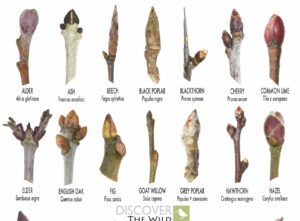
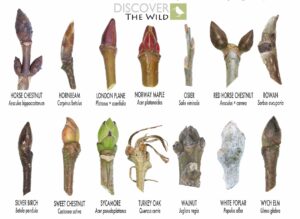
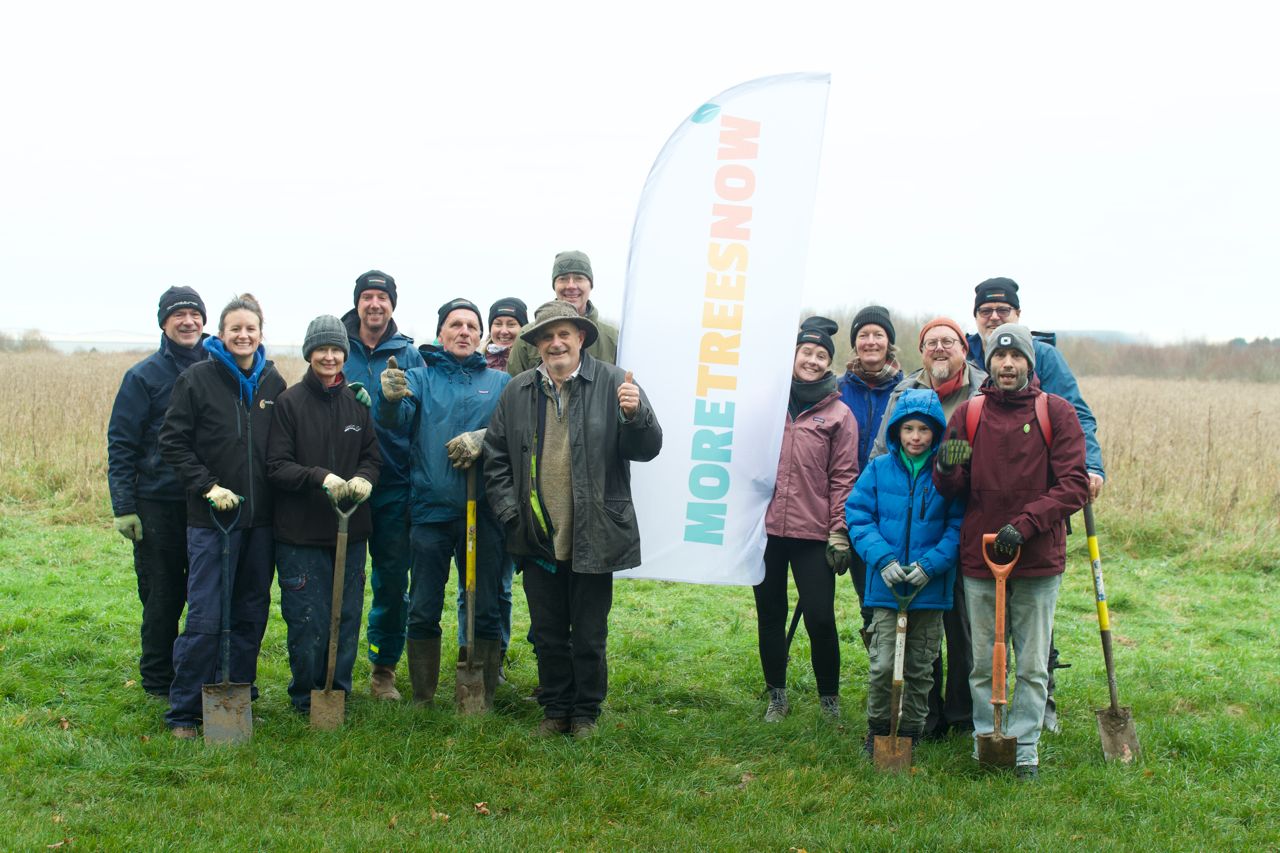
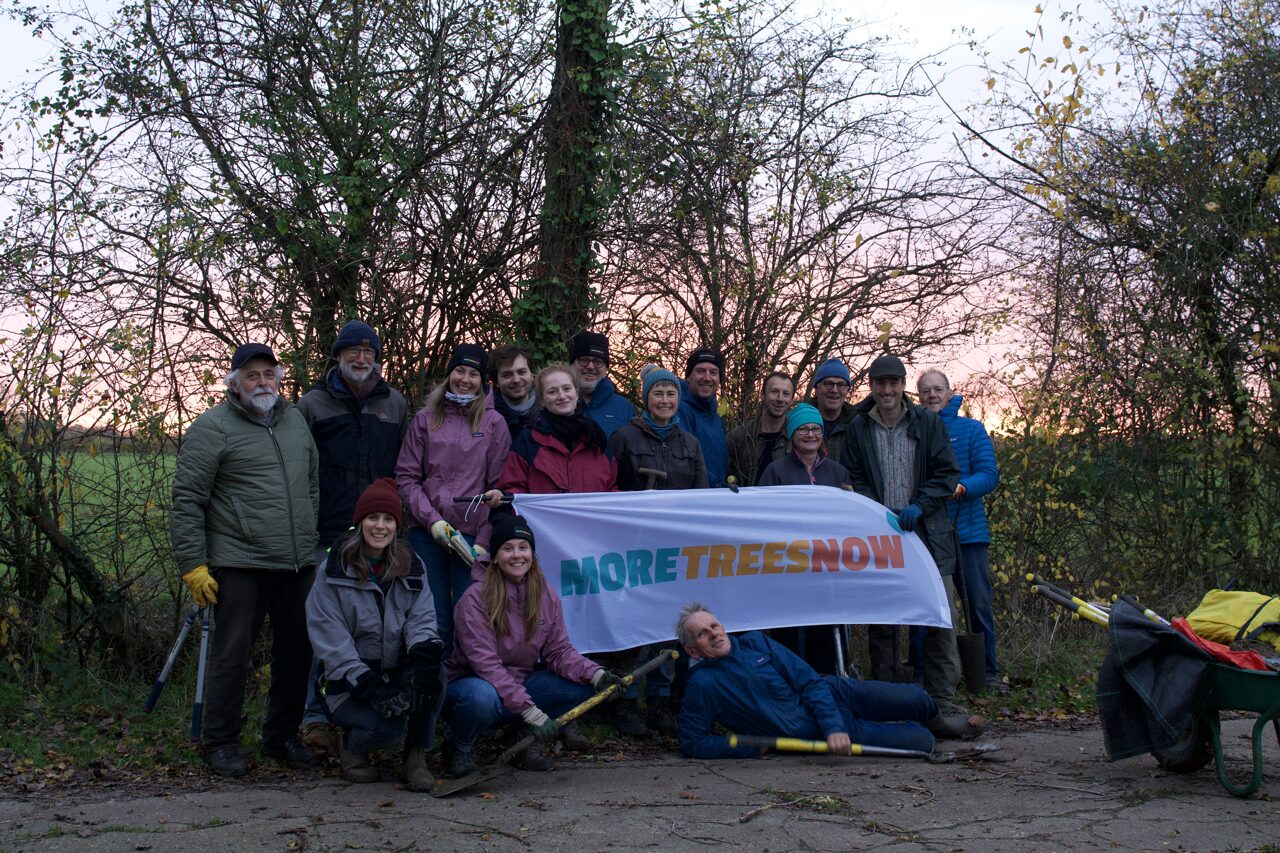

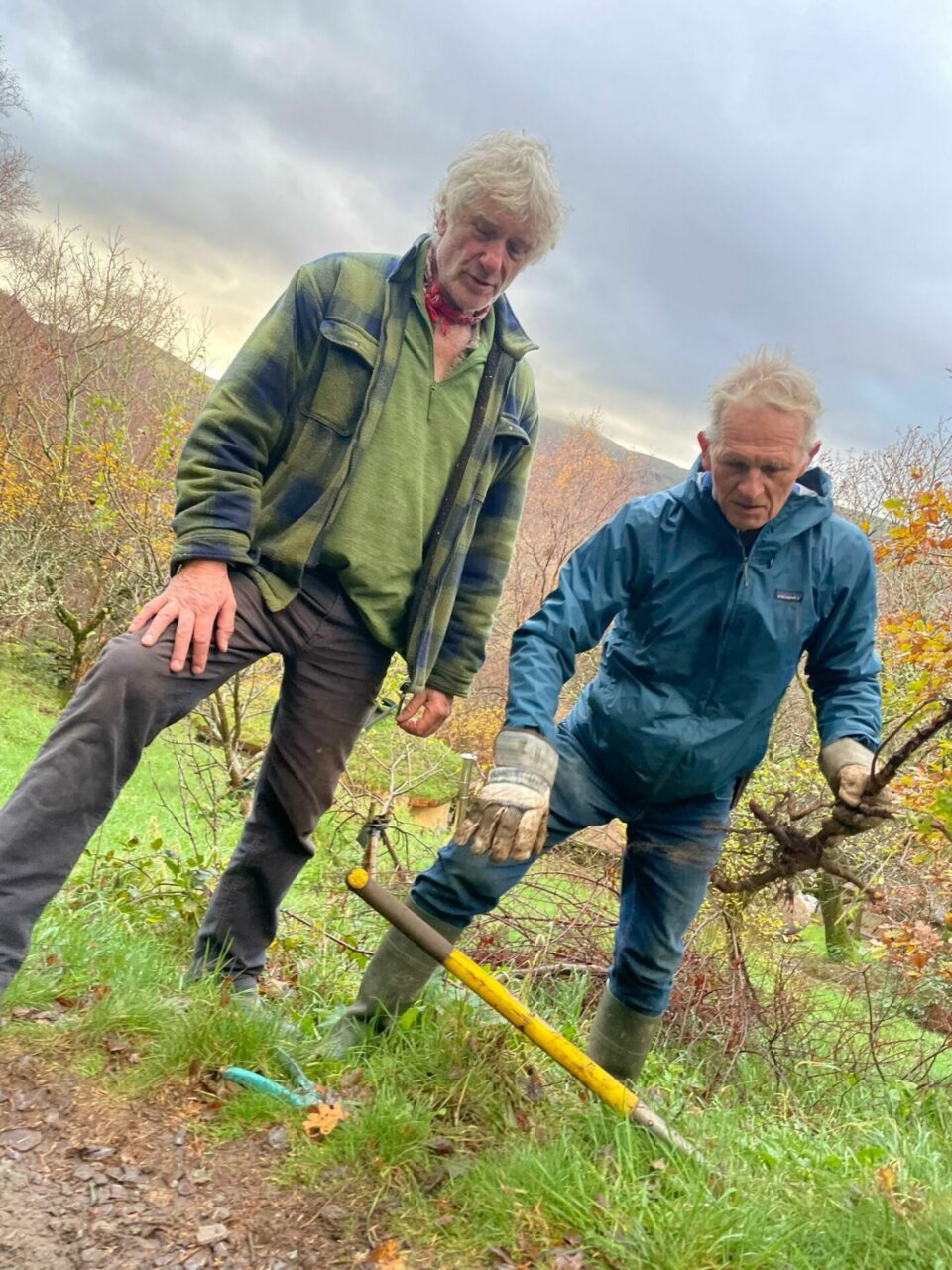

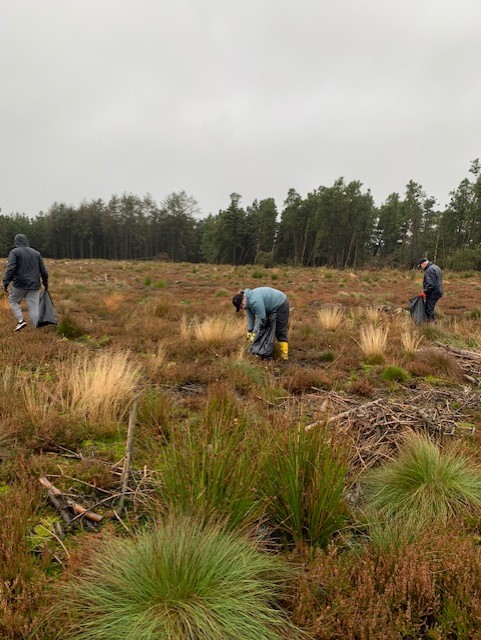
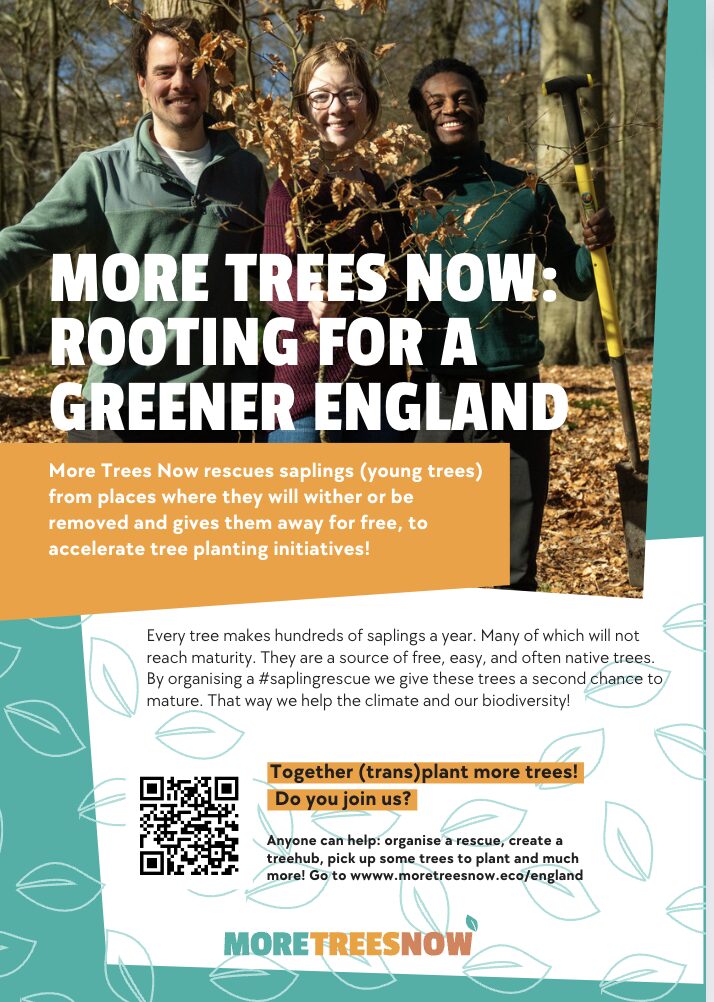
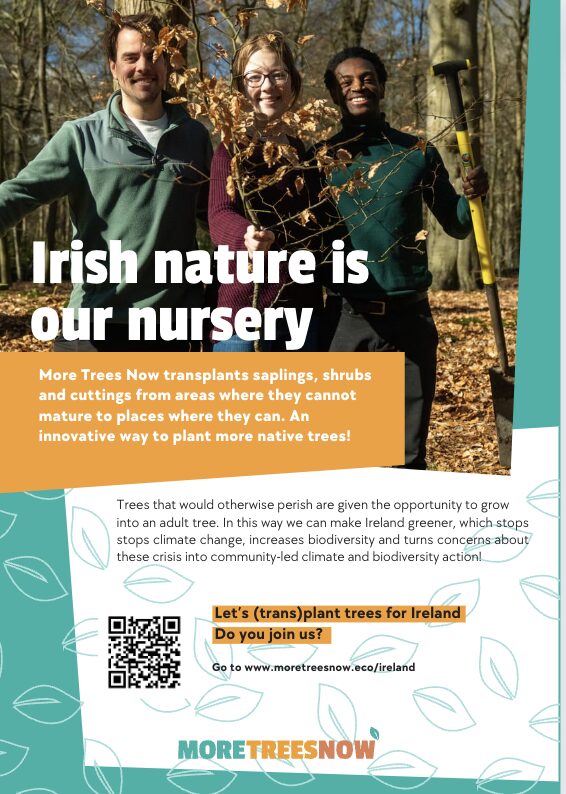
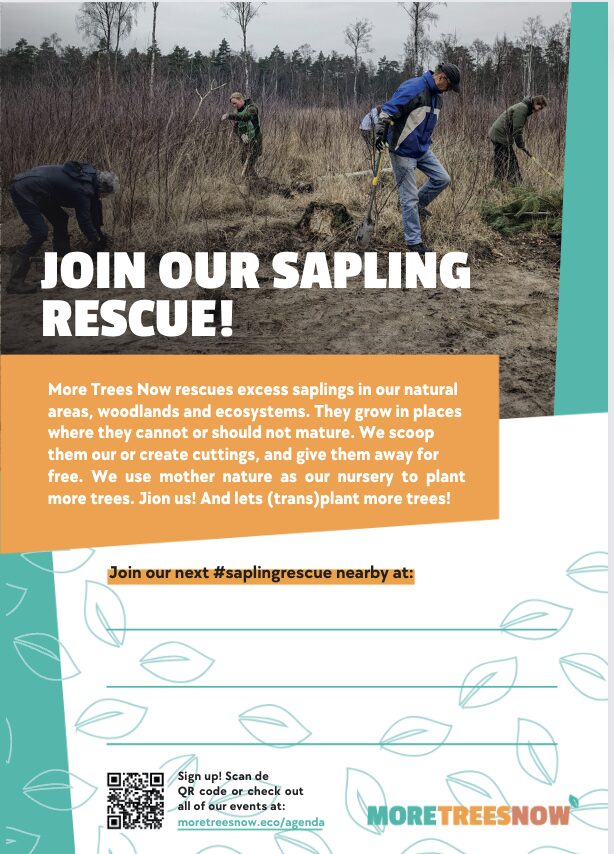
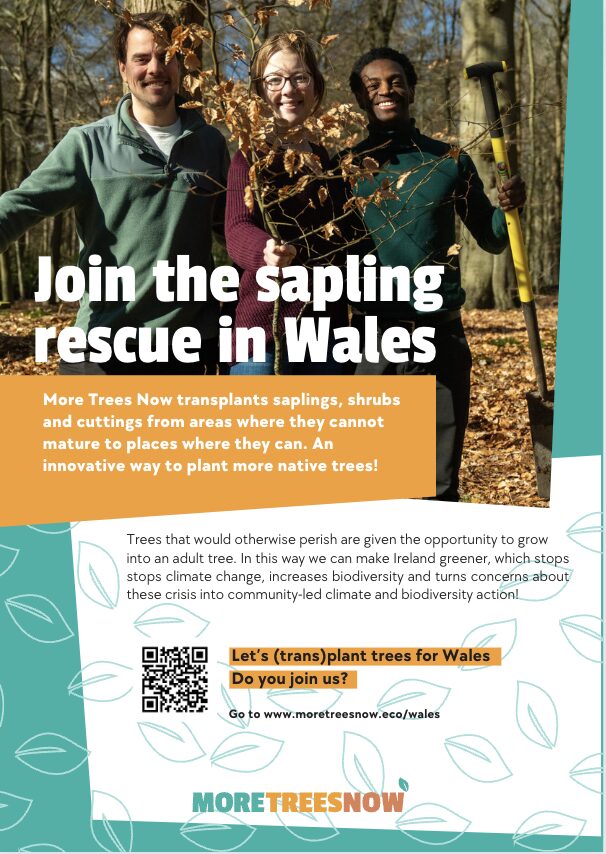

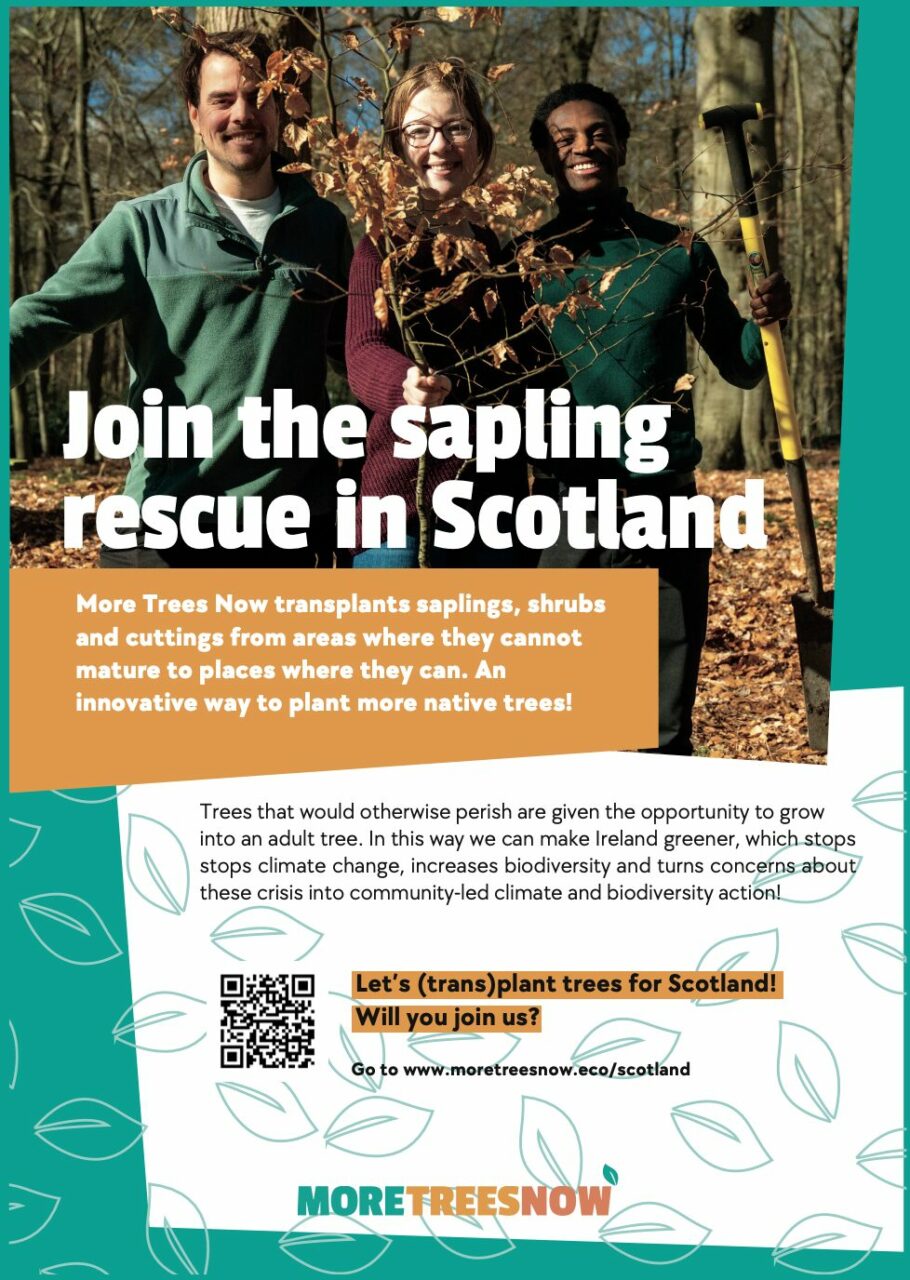
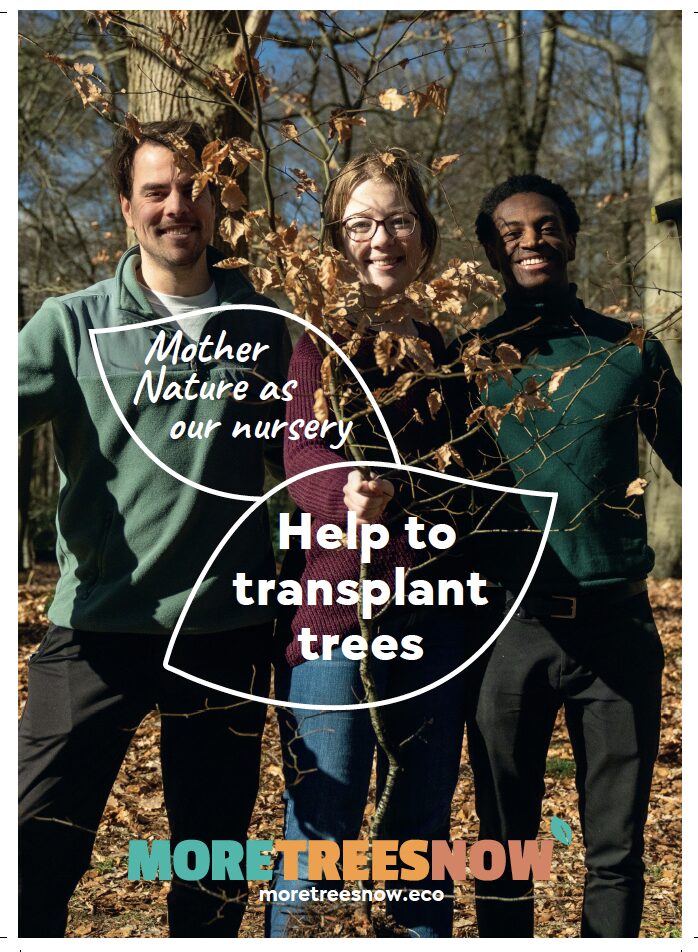
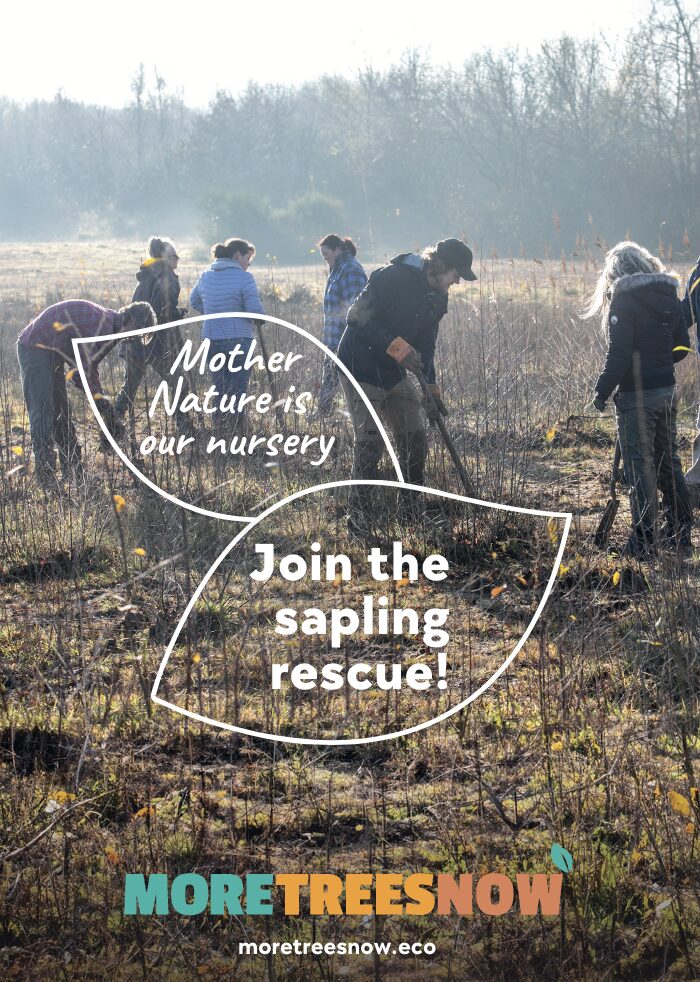


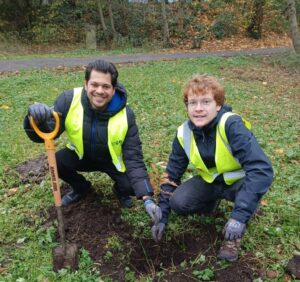
Social Media
Consider setting up your own social media account and posting about your event! You can refer to our social media accounts for some examples. You can use social media to call for volunteers and share photos from the event itself. When people see how successful and enjoyable your event was, they might attend the next one!